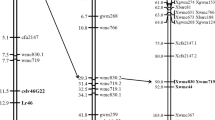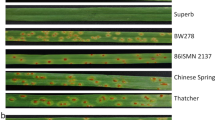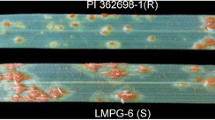Abstract
Host-plant resistance is the most economically viable and environmentally responsible method of control for Puccinia triticina, the causal agent of leaf rust in wheat (Triticum aestivum L.). The identification and utilization of new resistance sources is critical to the continued development of improved cultivars as shifts in pathogen races cause the effectiveness of widely deployed genes to be short lived. The objectives of this research were to identify and tag new leaf rust resistance genes. Forty landraces from Afghanistan and Iran were obtained from the National Plant Germplasm System and evaluated under field conditions at two locations in Texas. PI 289824, a landrace from Iran, was highly resistant under field infection. Further evaluation revealed that PI 289824 is highly resistant to a broad spectrum of leaf rust races, including the currently prevalent races of leaf rust in the Great Plains area of the USA. Eight F1 plants, 176 F2 individuals and 139 F2:3 families of a cross between PI 289824 and T112 (susceptible) were evaluated for resistance to leaf rust at the seedling stage. Genetic analysis indicated resistance in PI 289824 is controlled by a single dominant gene. The AFLP analyses resulted in the identification of a marker (P39 M48-367) linked to resistance. The diagnostic AFLP band was sequenced and that sequence information was used to develop an STS marker (TXW200) linked to the gene at a distance of 2.3 cM. The addition of microsatellite markers allowed the gene to be mapped to the short arm of Chromosome 5B. The only resistance gene to be assigned to Chr 5BS is Lr52. The Lr52 gene was reported to be 16.5 cM distal to Xgwm443 while the gene in PI 289824 mapped 16.7 cM proximal to Xgwm443. Allelism tests are needed to determine the relationship between the gene in PI 289824 and Lr52. If the reported map positions are correct, the gene in PI 289824 is unique.



Similar content being viewed by others
References
Browder LE (1971) Pathogenic specialization in cereal rust fungi, especially Puccinia recondita f. sp. tritici: concepts, methods of study and application. US Dept Agric Tech Bull 1432
Dyck PL, Jedel PE (1989) Genetics of resistance to leaf rust in two accessions of common wheat. Can J Plant Sci 69:531–534
Fritz AK, Caldwell S, Worrall WD (1999) Molecular mapping of Russian wheat aphid resistance from Triticale accession PI 386156. Crop Sci 39:1707–1710
Hiebert C, Thomas J, McCallum B (2002) Determining the chromosomal location of the wheat leaf-rust resistance gene LrW. Can J Plant Pathol 24:92–94
Hiebert C, Thomas J, McCallum B (2005) Locating the broad-spectrum wheat leaf rust resistance gene Lr52 (LrW) to chromosome 5B by a new cytogenetic method. Theor Appl Genet (in press)
Hittalmani S, Parco A, Mew TW, Zeigler RS, Huang N (2000) Fine mapping and DNA marker-assisted pyramiding of the three major genes for blast resistance in rice. Theor Appl Genet 100:1121–1128
Huang N, Angeles ER, Domingo J, Magpantay G, Singh S, Zhang G, Kumaravadivel N, Bennett J, Khush GS (1997) Pyramiding of bacterial blight genes in rice: marker assisted selection using RFLP and PCR. Theor Appl Genet 96:313–320
Kosambi DD (1944) The estimation of map distances from recombination values. Ann Eugen 12:172–175
Long DL (2004) Final cereal rust bulletin. Available at http://www.cdl.umn.edu/crb/2004crb/04crbfin.pdf. (accessed 25 November 2004). Cereal Disease Laboratory-USDA-ARS, St. Paul, Minn.
McIntosh, RA (1983) Genetic and cytogenetic studies involving Lr18 for resistance to Puccinia recondita. In: Sakamota S (ed) Proceedings of the sixth international wheat genetics symposium. Kyoto University, pp 777–783
McIntosh RA, Wellings CR, Park RF (1995) Wheat rusts: an atlas of resistance genes. CSIRO, Melbourne, p 9
Menz MA, Klein RR, Mullet JE, Obert JA, Unruh NC, Klein PE (2002) A high-density genetic map of Sorghum bicolor (L) Moench based on 2,926 AFLP, RFLP and SSR markers. Plant Mol Biol 48:483–499
Roelfs AP, Singh RP, Saari EE (1992) Rust diseases of wheat: concepts and methods of disease management. CIMMYT, Mexico
Singh S, Sidhu JS, Huang N, Vikal Y, Li Z, Brar DS, Dhaliwal HS, Khush GS (2001) Pyramiding three bacterial blight resistance genes (xa5, xa13 and Xa21) using marker-assisted selection into indica rice cultivar PR106. Theor Appl Genet 102:1011–1015
Somers DJ, Isaac P, Edwards K (2004) A high density microsatellite consensus map for bread wheat (Triticum aestivum L). Theor Appl Genet 109:1105–1114
Williams CE, Ronald PC (1994) PCR template-DNA isolated quickly from monocot and dicot leaves without tissue homogenization. Nucl Acids Res 22:1917–1918
Acknowledgements
The authors would like to acknowledge financial support from The Texas Higher Education Coordinating Board through the Advanced Technology Program.
Author information
Authors and Affiliations
Corresponding author
Additional information
Communicated by R. Bernardo
Rights and permissions
About this article
Cite this article
Obert, D.E., Fritz, A.K., Moran, J.L. et al. Identification and molecular tagging of a gene from PI 289824 conferring resistance to leaf rust (Puccinia triticina) in wheat. Theor Appl Genet 110, 1439–1444 (2005). https://doi.org/10.1007/s00122-005-1974-z
Received:
Accepted:
Published:
Issue Date:
DOI: https://doi.org/10.1007/s00122-005-1974-z




